Cloud-based image compression solutions are essential for e-commerce businesses looking to optimize website performance and enhance user experience. By reducing image sizes without sacrificing quality, these platforms not only improve loading times but also support scalability and security, ensuring efficient image delivery even during high traffic periods. With robust security features in place, e-commerce sites can protect sensitive customer data while reaping the benefits of advanced image management technologies.
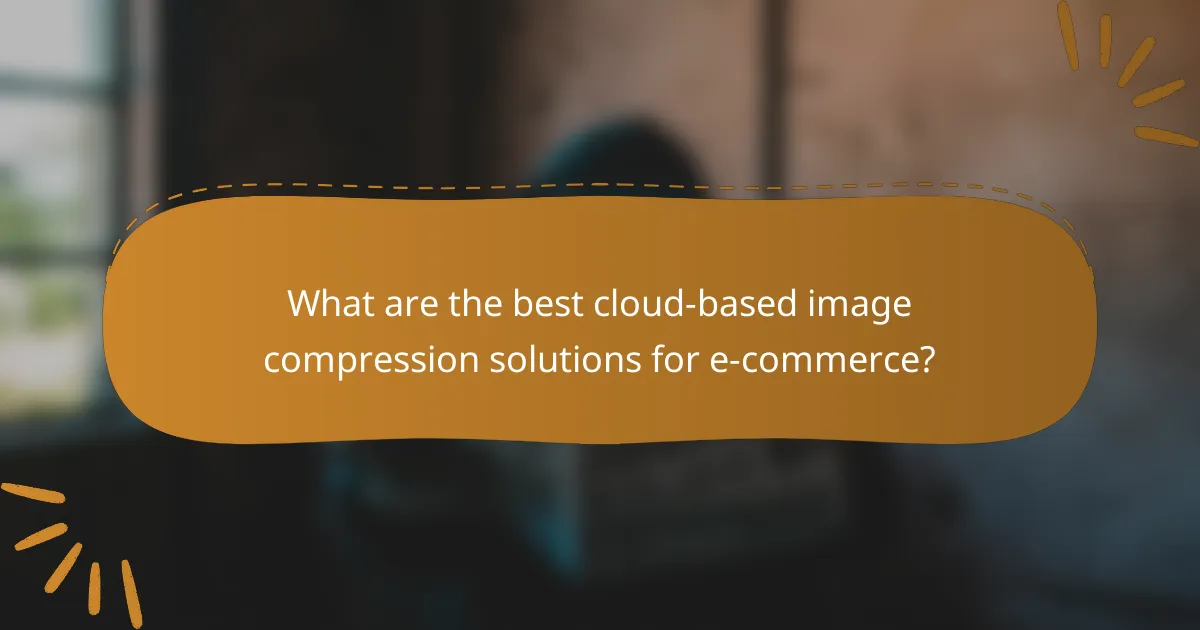
What are the best cloud-based image compression solutions for e-commerce?
The best cloud-based image compression solutions for e-commerce include Cloudinary, ImageKit, TinyPNG, Kraken.io, and Compressor.io. These platforms enhance website performance by reducing image sizes while maintaining quality, which is crucial for user experience and search engine optimization.
Cloudinary
Cloudinary is a comprehensive media management platform that offers powerful image compression capabilities tailored for e-commerce. It supports various formats and provides automatic optimization based on the user’s device and browser, ensuring fast loading times.
Consider using Cloudinary if your e-commerce site handles a large volume of images, as it offers scalability and advanced features like dynamic image transformations and responsive delivery. Its pay-as-you-go pricing model allows flexibility based on usage.
ImageKit
ImageKit is a real-time image optimization and transformation service that integrates seamlessly with existing e-commerce platforms. It provides instant image compression, reducing load times significantly, which can enhance user engagement and conversion rates.
This solution is particularly beneficial for businesses looking for a straightforward setup. ImageKit offers a free tier with limited features, making it accessible for startups and small businesses to test its capabilities before committing to a paid plan.
TinyPNG
TinyPNG specializes in lossless compression for PNG and JPEG images, making it ideal for e-commerce sites that prioritize image quality. It uses smart lossy compression techniques to reduce file sizes without noticeable quality loss.
For e-commerce businesses, TinyPNG can be integrated into workflows through its API or plugins for popular platforms like WordPress. This makes it easy to compress images in bulk, saving time and improving website performance.
Kraken.io
Kraken.io is another robust image optimization tool that offers both lossy and lossless compression options. It is particularly effective for e-commerce sites with large image libraries, as it can handle bulk uploads and optimize images efficiently.
Kraken.io provides a user-friendly interface and a straightforward API for developers. Its pricing model is based on the number of images processed, allowing businesses to choose a plan that fits their needs without overspending.
Compressor.io
Compressor.io is a simple yet effective tool for compressing images while maintaining high quality. It supports various formats, including JPEG, PNG, GIF, and SVG, making it versatile for different e-commerce applications.
This solution is ideal for businesses that require quick and easy image optimization without the need for extensive features. Compressor.io offers a free service, making it a cost-effective option for small to medium-sized e-commerce sites looking to improve loading speeds.
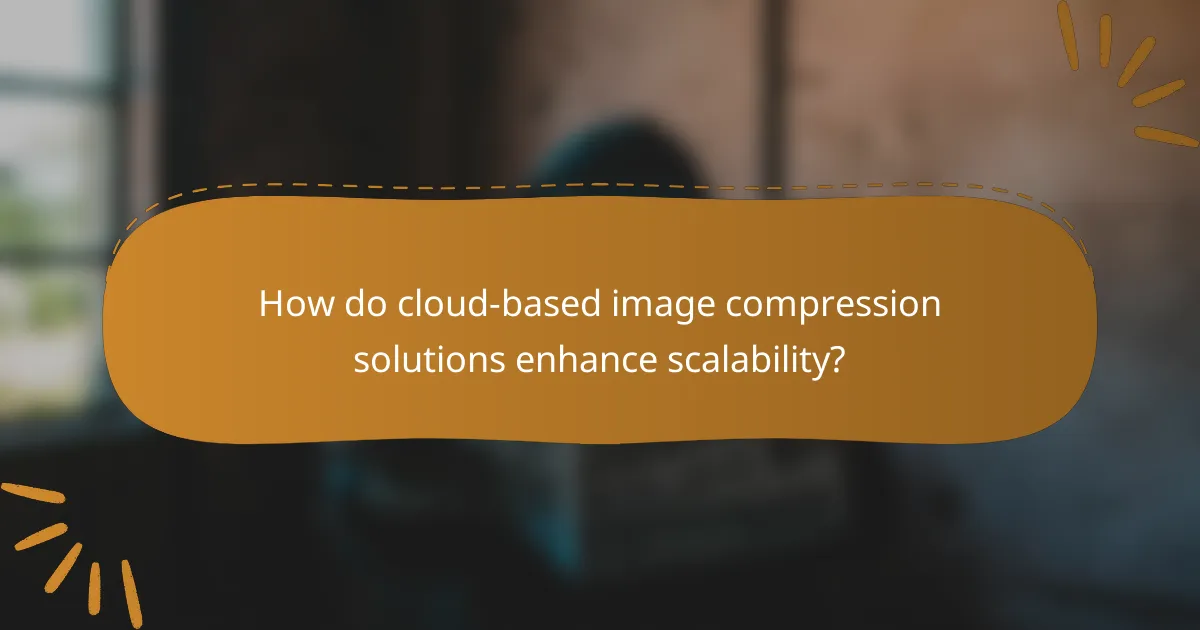
How do cloud-based image compression solutions enhance scalability?
Cloud-based image compression solutions enhance scalability by allowing e-commerce platforms to manage varying levels of traffic without compromising performance. These solutions automatically adjust resources based on demand, ensuring that image delivery remains efficient even during peak times.
Automatic scaling based on traffic
Automatic scaling enables cloud-based image compression services to dynamically allocate resources in response to traffic fluctuations. For instance, during a sale or promotional event, the system can increase processing power to handle a surge in image requests, ensuring that customers experience fast loading times.
When choosing a solution, consider options that offer real-time scaling capabilities. This feature can significantly reduce downtime and improve user experience, as images will load quickly regardless of the number of concurrent users accessing the site.
Dynamic image delivery
Dynamic image delivery optimizes the way images are served to users based on their device and connection speed. This means that high-resolution images can be delivered to users with fast connections, while lower-resolution versions are sent to those with slower speeds, enhancing overall performance.
To implement dynamic image delivery effectively, ensure that your cloud solution supports responsive image formats and adaptive quality settings. This approach not only improves loading times but also reduces bandwidth usage, which can lead to cost savings for e-commerce businesses.
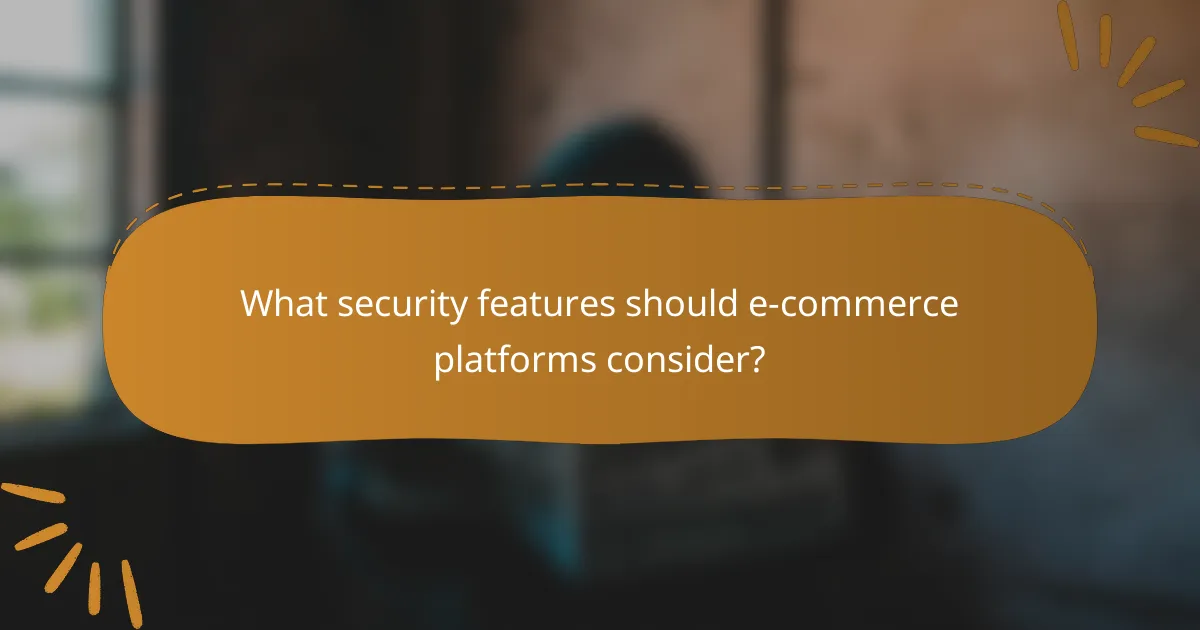
What security features should e-commerce platforms consider?
E-commerce platforms must prioritize security features such as data encryption and access control to protect sensitive customer information. Implementing these measures helps mitigate risks associated with data breaches and unauthorized access.
Data encryption during transfer
Data encryption during transfer ensures that sensitive information, such as credit card details and personal data, is securely transmitted over the internet. Utilizing protocols like HTTPS and TLS is essential for encrypting data in transit, making it unreadable to unauthorized parties.
When selecting an encryption method, consider using AES (Advanced Encryption Standard) with a key length of at least 256 bits for robust security. Regularly updating encryption protocols and certificates is also crucial to maintaining a secure environment.
Access control mechanisms
Access control mechanisms regulate who can view or interact with sensitive data on e-commerce platforms. Implementing role-based access control (RBAC) allows businesses to assign permissions based on user roles, ensuring that only authorized personnel can access critical information.
Additionally, consider using multi-factor authentication (MFA) to enhance security further. This method requires users to provide two or more verification factors, significantly reducing the risk of unauthorized access. Regular audits of access permissions can help identify and rectify any vulnerabilities in the system.
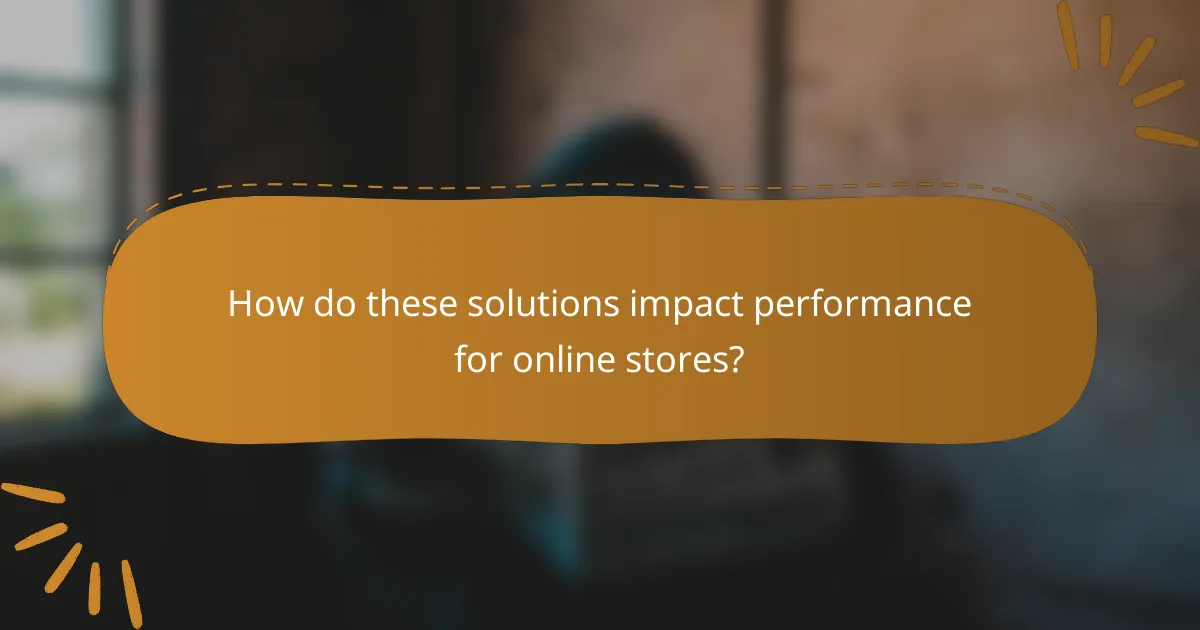
How do these solutions impact performance for online stores?
Cloud-based image compression solutions significantly enhance performance for online stores by reducing image file sizes, which leads to faster loading times. This improvement is crucial for retaining customers and boosting sales, as even slight delays can result in lost revenue.
Faster page load times
Faster page load times are a direct benefit of using cloud-based image compression. By optimizing images, stores can reduce the amount of data that needs to be transferred, often achieving load times in the low seconds or even milliseconds range. This is particularly important for e-commerce sites, where studies show that a one-second delay can decrease conversions by a notable percentage.
To maximize speed, consider using formats like WebP or AVIF, which offer superior compression without sacrificing quality. Additionally, employing a Content Delivery Network (CDN) can further enhance loading times by serving images from geographically closer servers.
Improved user experience
Improved user experience is another key advantage of cloud-based image compression. When images load quickly, customers are more likely to stay engaged and explore products, leading to higher satisfaction and increased likelihood of purchases. A seamless browsing experience can significantly differentiate a store from its competitors.
To enhance user experience, ensure that images maintain high visual quality even after compression. Regularly test your site’s performance using tools like Google PageSpeed Insights to identify areas for improvement. Avoid common pitfalls such as over-compression, which can lead to pixelation and deter potential buyers.
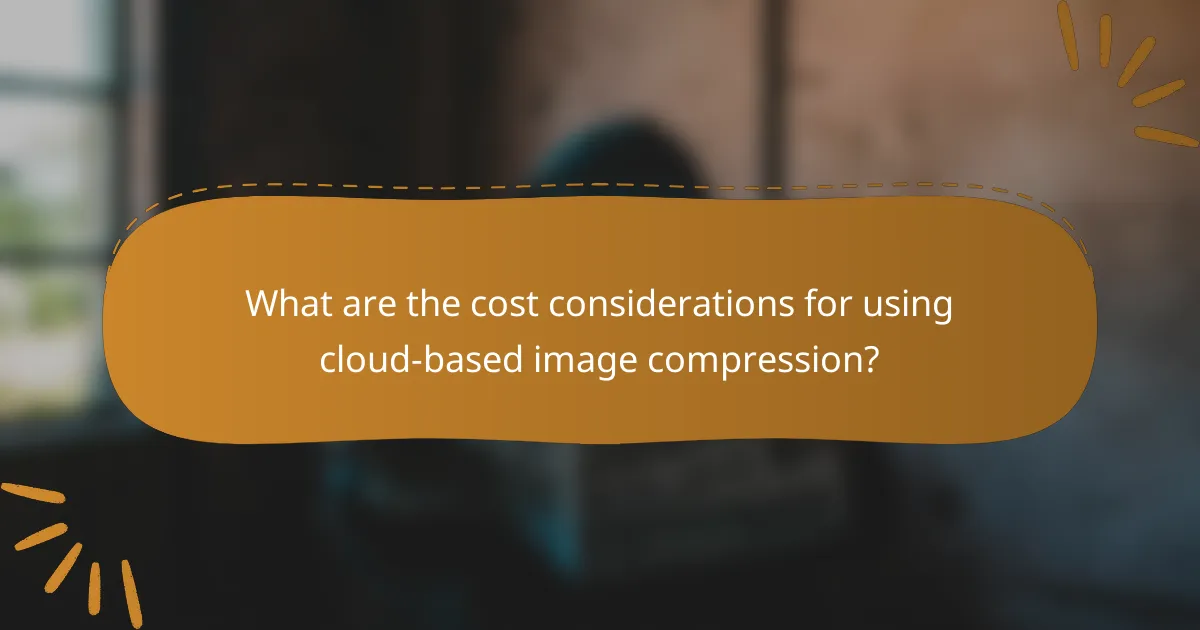
What are the cost considerations for using cloud-based image compression?
Cost considerations for cloud-based image compression include subscription fees, usage rates, and potential hidden costs. Understanding these factors helps e-commerce businesses budget effectively and choose the right service for their needs.
Subscription pricing models
Subscription pricing models typically involve a fixed monthly or annual fee for a set amount of usage, which can be beneficial for businesses with predictable image compression needs. These plans often include tiered options based on the volume of images processed or the level of service provided.
For example, a basic plan might start around $20 per month for up to 1,000 images, while more advanced plans could range from $50 to $200 monthly for higher limits and additional features like enhanced security or faster processing times. Businesses should assess their image volume to select the most cost-effective plan.
Pay-as-you-go options
Pay-as-you-go options charge users based on the actual amount of data processed, making them suitable for businesses with fluctuating image needs. This model allows for flexibility, as companies only pay for what they use, which can be particularly advantageous during peak seasons.
Pricing for pay-as-you-go services often ranges from $0.01 to $0.10 per image, depending on the compression quality and additional features. Businesses should monitor their usage closely to avoid unexpected costs and consider setting budget alerts to manage expenses effectively.

What are the prerequisites for implementing these solutions?
Implementing cloud-based image compression solutions requires a solid understanding of your e-commerce platform’s infrastructure, data handling capabilities, and specific business needs. Key prerequisites include reliable internet connectivity, suitable cloud service providers, and a clear strategy for integrating these solutions into existing workflows.
Understanding your e-commerce platform
Before adopting cloud-based image compression, assess your e-commerce platform’s compatibility with such solutions. Ensure that your platform supports APIs or plugins that facilitate image processing. Familiarize yourself with the platform’s image handling capabilities to determine how compression can enhance performance.
Choosing the right cloud service provider
Selecting a cloud service provider is crucial for effective image compression. Look for providers that offer scalability, security, and robust performance metrics. Consider factors such as data center locations, compliance with regulations like GDPR, and the provider’s reputation in the e-commerce sector.
Establishing a clear integration strategy
A well-defined integration strategy is essential for seamless implementation. Map out how the image compression solution will fit into your existing workflow, including upload processes and storage solutions. Test the integration in a controlled environment to identify potential issues before full deployment.
